Blogging Marvel’s Tomb of Dracula Magazine
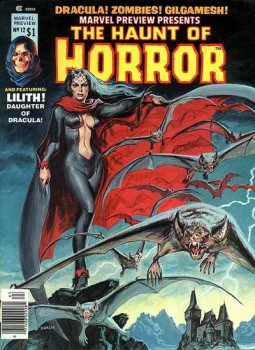
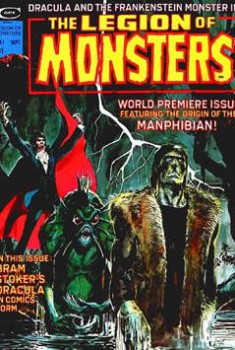 Dracula Lives was Marvel’s companion black and white companion title to the award-winning Tomb of Dracula monthly comic. As a magazine, Dracula Lives was exempt from the strictures of the Comic Code Authority, allowing for more violence and adult themes than would have been possible in the comic at the time. The Legion of Monsters #1 in 1975 and Marvel Preview #12 in 1977 collected three orphan tales – two originally slated for Dracula Lives and the other for Vampire Tales as both titles had ceased publication by this point.
Dracula Lives was Marvel’s companion black and white companion title to the award-winning Tomb of Dracula monthly comic. As a magazine, Dracula Lives was exempt from the strictures of the Comic Code Authority, allowing for more violence and adult themes than would have been possible in the comic at the time. The Legion of Monsters #1 in 1975 and Marvel Preview #12 in 1977 collected three orphan tales – two originally slated for Dracula Lives and the other for Vampire Tales as both titles had ceased publication by this point.
Chapter Seven of Roy Thomas and Dick Giordano’s masterful adaptation of Bram Stoker’s classic was salvaged from Dracula Lives to appear in the debut issue of The Legion of Monsters. The story advances to the point where Professor Van Helsing is brought in by Dr. Seward in an ill-fated effort to save Lucy Westenra’s life. This would be the last installment to see print until the two legendary comics creators reunited decades later to finish the project for Marvel as previously covered in detail in our earlier article on comic adaptations of the Stoker novel.
“Profits are Plunging” was a Steve Gerber solo tale of Lilith, Daughter of Dracula that made its way from Vampire Tales to Marvel Preview. Frank Springer’s artwork is strictly run of the mill, but Gerber’s solid story offers an effective criticism of 1960s idealism giving way to 1970s corporate greed. Martin Gold, the series’ resident Greenwich Village hippie, accepts a PR job to help provide for his pregnant girlfriend, Angel O’Hara. Of course, the conservative capitalists at the chemical company whose compound Martin is supposed to successfully sell to the youth of America are well aware their product will harm both the environment and animal life and are willing to off Martin when he decides to play whistle-blower. This gives Lilith an opportunity to take over her host form of Angel O’Hara to save Martin and take vengeance on the men whose corrupting greed outweighs their respect for life.
Doug Moench’s lost Dracula Lives tale, “Picture of Andrea” is an effective variation on the film noir classic Laura, aided and abetted by the gorgeous artwork of Sonny Trinidad. His depiction of the Lord of Vampires is the equal of Gene Colan. It is appropriate that a story so concerned with the beauty of the human form be graced with an artist capable of illustrating it to perfection.
As noted at the conclusion of our thirteen-part series on the monthly Tomb of Dracula comic series, Marvel’s decision in 1979 to cancel the acclaimed title was for the sole purpose of migrating it to serve as the flagship of their revitalized adult black & white comic magazine line. Regrettably, the results were decidedly mixed. While Marv Wolfman and Gene Colan were originally in place to continue the series, the title soon fell to little more than a rerun of Dracula Lives with various writers and artists chronicling the Vampire Lord’s otherwise unconnected adventures in the past and present. Unsurprisingly, the title was cancelled after only six issues.
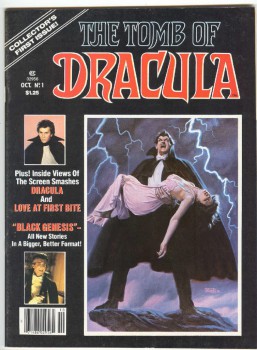 When the first issue debuted in October 1979, the resurrected Tomb of Dracula showed great promise. Marv Wolfman and Gene Colan’s epic, “Black Genesis,” raised the ante with an ambitious story that opens nearly two-thousand years in the past with Gholem Yazdi, the Magi who allegedly found the Star of Bethlehem when it fell to Earth and learned of the terrible power it possessed. Throughout the course of the story, Wolfman unveils the history of the Star of Bethlehem and those that sought to possess its power. We learn how it unleashed the Black Plague and of the fate of Augustus Ebers, the sorcerer who fell victim to Dracula when the vampire attempted to take possession of it. The story mainly focuses on two women – Florence Ebers, Augustus’s widow, who is driven to succeed where her husband failed even at the cost of resurrecting Dracula, and Sandy Sommers, one of Wolfman’s many lost souls who drift through life without purpose, being used and discarded by others. Colan’s phenomenal artistic gifts coupled with Wolfman’s superior story-telling ability render this an unappreciated classic. The return of Scotland Yard’s Inspector Chelm is a welcome one with the promise that Frank Drake and Rachel Van Helsing will eventually form a new team of vampire hunters with the good Inspector. Sadly, it was not to be. After nearly 50 pages of brilliant and mature comic art, the remaining five issues soon lost their way.
When the first issue debuted in October 1979, the resurrected Tomb of Dracula showed great promise. Marv Wolfman and Gene Colan’s epic, “Black Genesis,” raised the ante with an ambitious story that opens nearly two-thousand years in the past with Gholem Yazdi, the Magi who allegedly found the Star of Bethlehem when it fell to Earth and learned of the terrible power it possessed. Throughout the course of the story, Wolfman unveils the history of the Star of Bethlehem and those that sought to possess its power. We learn how it unleashed the Black Plague and of the fate of Augustus Ebers, the sorcerer who fell victim to Dracula when the vampire attempted to take possession of it. The story mainly focuses on two women – Florence Ebers, Augustus’s widow, who is driven to succeed where her husband failed even at the cost of resurrecting Dracula, and Sandy Sommers, one of Wolfman’s many lost souls who drift through life without purpose, being used and discarded by others. Colan’s phenomenal artistic gifts coupled with Wolfman’s superior story-telling ability render this an unappreciated classic. The return of Scotland Yard’s Inspector Chelm is a welcome one with the promise that Frank Drake and Rachel Van Helsing will eventually form a new team of vampire hunters with the good Inspector. Sadly, it was not to be. After nearly 50 pages of brilliant and mature comic art, the remaining five issues soon lost their way.
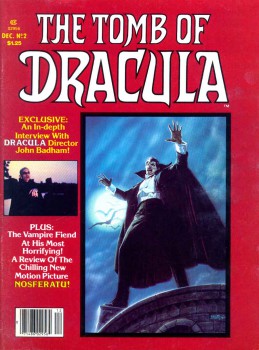 Issue #2 started things off with Marv Wolfman and Steve Ditko’s “The Dimensional Man.” The idea of pairing a writer of Wolfman’s caliber with Ditko sounds promising, but the artist was a long way from his Silver Age burst of invention that ushered in so many classic Marvel properties. Wolfman’s strictly routine story concerns Satanists and a Lovecraftian demon with Dracula shoehorned into the mix rather awkwardly. This is a filler story that discards the plot threads from the first issue. The back-up feature is an orphaned tale originally prepared for Dracula Lives. “Court of the Dead” is another 15th Century tale of the historical Dracula with Marv Wolfman’s script borrowing heavily from Radu Florescu and Raymond McNally’s research into the folklore surrounding Vlad the Impaler. Frank Robbins and John Romita’s artwork is serviceable, but represents neither man’s talent at their best.
Issue #2 started things off with Marv Wolfman and Steve Ditko’s “The Dimensional Man.” The idea of pairing a writer of Wolfman’s caliber with Ditko sounds promising, but the artist was a long way from his Silver Age burst of invention that ushered in so many classic Marvel properties. Wolfman’s strictly routine story concerns Satanists and a Lovecraftian demon with Dracula shoehorned into the mix rather awkwardly. This is a filler story that discards the plot threads from the first issue. The back-up feature is an orphaned tale originally prepared for Dracula Lives. “Court of the Dead” is another 15th Century tale of the historical Dracula with Marv Wolfman’s script borrowing heavily from Radu Florescu and Raymond McNally’s research into the folklore surrounding Vlad the Impaler. Frank Robbins and John Romita’s artwork is serviceable, but represents neither man’s talent at their best.
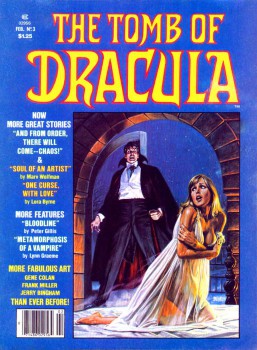 Issue #3 delivers a tale worthy of the magazine’s title with Marv Wolfman and Gene Colan’s “And From Order There Will Come Chaos.” The story concerns Anna Reynolds, a victim of Dracula who survived his attack seven years before, but who finds the vampire’s wrath extends to her young daughter Jackie, who was not yet born at the time her mother first encountered the vampire. While the story owes much to William Peter Blatty’s The Exorcist, the influence is fitting and Wolfman and Colan deliver a strong story that is without equal in its treatment of Dracula as a force of Satanic fury. There is little to find appealing about the vampire in this tale, but all forty pages make for gripping reading. This is another unappreciated gem.
Issue #3 delivers a tale worthy of the magazine’s title with Marv Wolfman and Gene Colan’s “And From Order There Will Come Chaos.” The story concerns Anna Reynolds, a victim of Dracula who survived his attack seven years before, but who finds the vampire’s wrath extends to her young daughter Jackie, who was not yet born at the time her mother first encountered the vampire. While the story owes much to William Peter Blatty’s The Exorcist, the influence is fitting and Wolfman and Colan deliver a strong story that is without equal in its treatment of Dracula as a force of Satanic fury. There is little to find appealing about the vampire in this tale, but all forty pages make for gripping reading. This is another unappreciated gem.
Peter Gillis penned “Bloodline,” a useful text piece on the chronology of the character through his Marvel appearances, while Lora Byrne contributed a short story spotlighting Lilith, Daughter of Dracula in “One Curse, With Love.” The issue concluded with Marv Wolfman and Gene Colan’s brief filler tale, “Soul of an Artist,” which reads like an unofficial sequel to Doug Moench’s “Picture of Andrea.” Sadly, this marked the end of Marv Wolfman’s association with the magazine, due to personal disagreements with the title’s editor, Jim Shooter. The change in direction was to be a drastic one, with the promise of a new take on both the vampire lord and his daughter for the next issue.
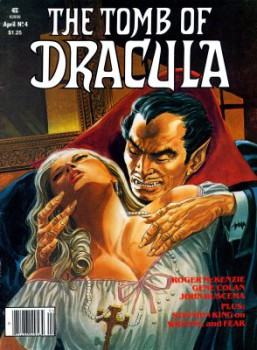 Issue #4 kicked off the magazine’s new direction with a historical tale that borrowed more than a bit from Stoker’s novel. “Angelica” saw the debut of new writer Roger McKenzie. Editor Jim Shooter’s decision to pair McKenzie with Gene Colan was a savvy one to help ease the transition. Colan’s artwork is as glorious as ever in this well-written turn of the last century atmospheric horror tale set in a lighthouse. As much as I remain enamored of Marv Wolfman’s interpretation of the character, McKenzie did an admirable job. The real pity is the decision was made to lose the direction promised in the first issue that might have resulted in a successful transition from the monthly comic to a magazine format with a continuing narrative.
Issue #4 kicked off the magazine’s new direction with a historical tale that borrowed more than a bit from Stoker’s novel. “Angelica” saw the debut of new writer Roger McKenzie. Editor Jim Shooter’s decision to pair McKenzie with Gene Colan was a savvy one to help ease the transition. Colan’s artwork is as glorious as ever in this well-written turn of the last century atmospheric horror tale set in a lighthouse. As much as I remain enamored of Marv Wolfman’s interpretation of the character, McKenzie did an admirable job. The real pity is the decision was made to lose the direction promised in the first issue that might have resulted in a successful transition from the monthly comic to a magazine format with a continuing narrative.
McKenzie also penned the back-up feature, “Death Vow,” highlighted by the impressive artwork of John Buscema and Klaus Janson. This was no mere filler story, but an interesting companion to the historical tale that opened the issue. Once again, McKenzie drew heavily from Stoker’s novel for inspiration. The decision to alter the title into little more than a revived version of Dracula Lives was an odd choice from a commercial standpoint, but not without artistic merit.
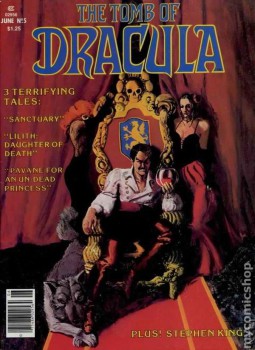 Issue #5 spotlighted Roger McKenzie and Gene Colan’s tale of terror in modern day Transylvania, “Sanctuary.” The story drew heavily on the continuity from the monthly title, with Dracula disgusted by the vampire legion he commands in his homeland. A flashback to the historical Dracula’s 15th Century exploits sets up the follow-up story scripted by Ralph Macchio and Lynn Graeme. “Lilith, Daughter of Dracula” reintroduced the character into the storyline and brought some closure to the back-story of Angel O’Hara. Gene Colan’s artwork throughout both halves of this two-part tale is never short of magnificent. Surprisingly, the two scripts dovetail perfectly, climaxing in what appears to be the ultimate confrontation between Dracula and his daughter. Unlike the preceding issue, this one seemed bound and determined to acknowledge Marv Wolfman’s work and, it must be said, that McKenzie as well as Macchio and Graeme did an admirable job of carrying on with the series. The last story in the issue, “Pavane For an Undead Princess,” scripted by Peter Gillis and illustrated by John Buscema, is almost certainly an orphan tale originally earmarked for Dracula Lives. While brief, this Dracula ballet is well-written, draws from Stoker’s original work for inspiration, and features excellent, if a bit dated, artwork throughout.
Issue #5 spotlighted Roger McKenzie and Gene Colan’s tale of terror in modern day Transylvania, “Sanctuary.” The story drew heavily on the continuity from the monthly title, with Dracula disgusted by the vampire legion he commands in his homeland. A flashback to the historical Dracula’s 15th Century exploits sets up the follow-up story scripted by Ralph Macchio and Lynn Graeme. “Lilith, Daughter of Dracula” reintroduced the character into the storyline and brought some closure to the back-story of Angel O’Hara. Gene Colan’s artwork throughout both halves of this two-part tale is never short of magnificent. Surprisingly, the two scripts dovetail perfectly, climaxing in what appears to be the ultimate confrontation between Dracula and his daughter. Unlike the preceding issue, this one seemed bound and determined to acknowledge Marv Wolfman’s work and, it must be said, that McKenzie as well as Macchio and Graeme did an admirable job of carrying on with the series. The last story in the issue, “Pavane For an Undead Princess,” scripted by Peter Gillis and illustrated by John Buscema, is almost certainly an orphan tale originally earmarked for Dracula Lives. While brief, this Dracula ballet is well-written, draws from Stoker’s original work for inspiration, and features excellent, if a bit dated, artwork throughout.
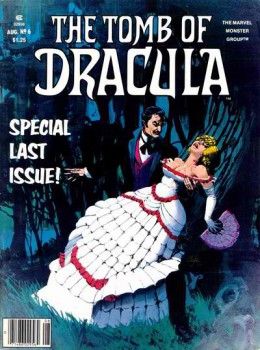 Issue #6 announced itself as the last issue from the front cover. Sadly, Roger McKenzie was nowhere in sight. Editor Jim Shooter scripted the historical tale, “A House Divided,” with Gene Colan providing his usually superb artwork. Shooter may well have been a better writer than he was an editor. While the idea of Dracula in the States during the Civil War poses some continuity problems for the series, the story itself and Colan’s artwork are never anything short of captivating. Shooter makes good use of the voodoo superstitions of the plantation slaves for suitable atmosphere. Needless to say, the influence of Stoker’s original novel is once again felt heavily on the story. “Violets for a Vampire” is the Lilith, Daughter of Dracula supporting feature. Lynn Graeme and Ralph Macchio’s script picks up the storyline where the last issue left off. Regrettably, their story appears as rushed as Gene Colan’s artwork and the result is surprisingly unsatisfying.
Issue #6 announced itself as the last issue from the front cover. Sadly, Roger McKenzie was nowhere in sight. Editor Jim Shooter scripted the historical tale, “A House Divided,” with Gene Colan providing his usually superb artwork. Shooter may well have been a better writer than he was an editor. While the idea of Dracula in the States during the Civil War poses some continuity problems for the series, the story itself and Colan’s artwork are never anything short of captivating. Shooter makes good use of the voodoo superstitions of the plantation slaves for suitable atmosphere. Needless to say, the influence of Stoker’s original novel is once again felt heavily on the story. “Violets for a Vampire” is the Lilith, Daughter of Dracula supporting feature. Lynn Graeme and Ralph Macchio’s script picks up the storyline where the last issue left off. Regrettably, their story appears as rushed as Gene Colan’s artwork and the result is surprisingly unsatisfying.
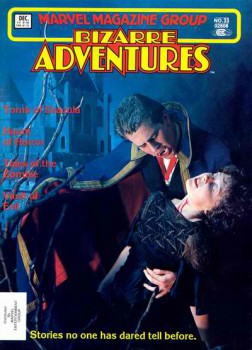 The series concluded with the promise that an orphaned tale would see print in an upcoming issue of Marvel Preview, yet it was another Marvel magazine, Bizarre Adventures that had the honor of printing the final Marvel black & white magazine tale in Issue #33 in December 1982. “The Blood Bequest” was Steve Perry’s reworking of Dracula’s vampiric origin as first told by Marv Wolfman in Dracula Lives #2. Steve Bissette’s artwork paid homage to Neal Adams’s work in that classic issue. The results are curiously mixed. The sole purpose of Perry’s rewrite seems to be to retcon the Atlantean vampire lord Varnae into the storyline. It is a good script that sticks closely to Wolfman’s continuity, simply offering a different perspective to tell the same tale. Bissette’s talent as an artist is undeniable (it is no mean feat to compare favorably with Neal Adams), but the result is such a slavish imitation of what went before that as an epilogue to this once great series, it seems a strangely muted finale rather than a glorious reinvention that pointed the way for what would follow.
The series concluded with the promise that an orphaned tale would see print in an upcoming issue of Marvel Preview, yet it was another Marvel magazine, Bizarre Adventures that had the honor of printing the final Marvel black & white magazine tale in Issue #33 in December 1982. “The Blood Bequest” was Steve Perry’s reworking of Dracula’s vampiric origin as first told by Marv Wolfman in Dracula Lives #2. Steve Bissette’s artwork paid homage to Neal Adams’s work in that classic issue. The results are curiously mixed. The sole purpose of Perry’s rewrite seems to be to retcon the Atlantean vampire lord Varnae into the storyline. It is a good script that sticks closely to Wolfman’s continuity, simply offering a different perspective to tell the same tale. Bissette’s talent as an artist is undeniable (it is no mean feat to compare favorably with Neal Adams), but the result is such a slavish imitation of what went before that as an epilogue to this once great series, it seems a strangely muted finale rather than a glorious reinvention that pointed the way for what would follow.
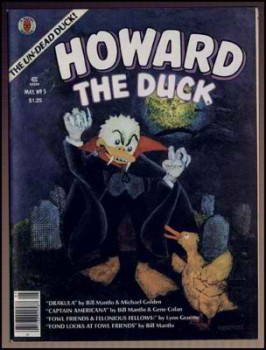 There was one side trip along the way that is worth noting. Issue #5 of Marvel’s Howard the Duck magazine in May 1980 featured “The Tomb of Drakula” as the lead story. The idea of Steve Gerber’s offbeat comics parody in the hands of another writer was jarring enough, but what about a book featuring Gene Colan as the artist that failed to assign him to illustrate their Tomb of Dracula crossover? It seems likely that Colan turned the job down as writer Bill Mantlo crafted a rather mean-spirited depiction of behind the scenes goings on at Marvel’s premier horror magazine with Marv Wolfman’s alter ego, Harold H. Harold, fired from his day job by his editor whom artist Michael Golden renders in the likeness of Jim Shooter. The editor’s remarks that Harold has gone stale on the title he built up and wrote for years and seems to believe he created rather than Bram Stoker seem particularly pointed. Along the way, Howard the Duck ends up a victim of Dracula and Harold H. Harold assembles his own band of vampire hunters to route the Lord of Vampires and free Howard from the vampire’s curse. They succeed, but only at the cost of Harold’s life as the vampire’s chronicler ends up Dracula’s victim. Surprisingly, Roger Stern kept this story part of Marvel’s official continuity when he decided to kill off all vampires in the Marvel Universe in the pages of Doctor Strange in 1983, but that’s a story for another day.
There was one side trip along the way that is worth noting. Issue #5 of Marvel’s Howard the Duck magazine in May 1980 featured “The Tomb of Drakula” as the lead story. The idea of Steve Gerber’s offbeat comics parody in the hands of another writer was jarring enough, but what about a book featuring Gene Colan as the artist that failed to assign him to illustrate their Tomb of Dracula crossover? It seems likely that Colan turned the job down as writer Bill Mantlo crafted a rather mean-spirited depiction of behind the scenes goings on at Marvel’s premier horror magazine with Marv Wolfman’s alter ego, Harold H. Harold, fired from his day job by his editor whom artist Michael Golden renders in the likeness of Jim Shooter. The editor’s remarks that Harold has gone stale on the title he built up and wrote for years and seems to believe he created rather than Bram Stoker seem particularly pointed. Along the way, Howard the Duck ends up a victim of Dracula and Harold H. Harold assembles his own band of vampire hunters to route the Lord of Vampires and free Howard from the vampire’s curse. They succeed, but only at the cost of Harold’s life as the vampire’s chronicler ends up Dracula’s victim. Surprisingly, Roger Stern kept this story part of Marvel’s official continuity when he decided to kill off all vampires in the Marvel Universe in the pages of Doctor Strange in 1983, but that’s a story for another day.
William Patrick Maynard was authorized to continue Sax Rohmer’s Fu Manchu thrillers beginning with The Terror of Fu Manchu (2009; Black Coat Press). A sequel, The Destiny of Fu Manchu was published earlier this year by Black Coat Press. Next up is a collection of short stories featuring an Edwardian detective, The Occult Case Book of Shankar Hardwicke and a hardboiled detective novel, Lawhead. To see additional articles by William, visit his blog at SetiSays.blogspot.com
[…] Blogging Marvel’s Tomb of Dracula Magazine […]